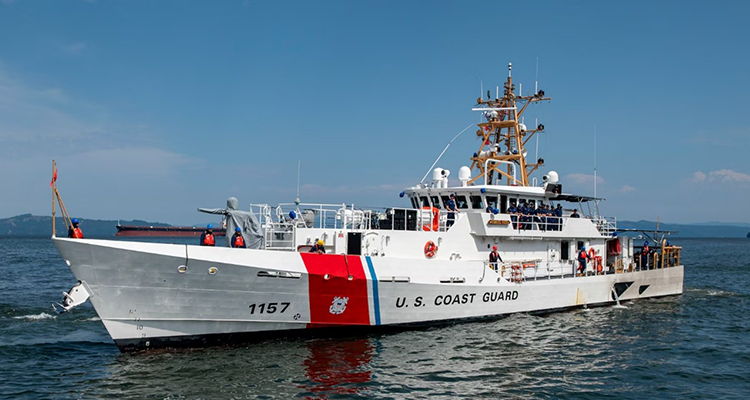Oct. 30, 2024 —

Coast Guard Cutter Florence Finch was commissioned in Seattle on Oct. 24, 2024. It will be homeported in Astoria, Oregon. U.S. Coast Guard photo.
The Coast Guard commissioned Coast Guard Cutter Florence Finch on Oct. 24 in Seattle. Florence Finch is the 57th fast response cutter (FRC) in service and the second to be homeported in Astoria, Oregon, joining Coast Guard Cutter David Duren.
Rear. Adm. Charles Fosse, Coast Guard 13th District commander, presided over the ceremony. Members of the Finch family were in attendance, including Finch’s daughter and cutter sponsor, Elizabeth L. Murphy, and her son, Bob Finch, who served as the Long Glass presenter, a traditional representation of the commanding officer’s authority and used to symbolically set the vessel’s first watch.
The cutter’s namesake, Florence Finch, was born in the Philippines in 1915, the daughter of a U.S. Army veteran and Filipino mother. After graduating high school, Finch worked for the Army intelligence unit in Manila under Gen. Douglas MacArthur and soon after met and married Chief Petty Officer Charles Smith, a U.S. Navy PT boat crew member. Smith died in 1942 while attempting to resupply American and Filipino troops trapped on Corregidor Island and the Bataan Peninsula during the Japanese invasion of the Philippines.
Finch initially evaded internment during the Japanese occupation of Manila by concealing her American heritage. Taking advantage of her position with the Japanese-controlled Philippine Liquid Fuel Distribution Union, she wrote vouchers for fuel distribution, diverted fuel supplies to the Philippine underground and participated in other acts of resistance. Finch’s secret exploits were eventually discovered; after her arrest in October 1944, she was interrogated, beaten and tortured before being sentenced to three years of hard labor. Finch weighed only 80 pounds when she was released by American forces who liberated Manila in February 1945. She never revealed any information about the resistance movement to the enemy.
On July 13, 1945, Finch enlisted in the U.S. Coast Guard as part of the Women’s Reserve, inspired by the memory of her late husband and a desire to continue the fight against the enemy. She was released from service after the end of World War II and moved to Ithaca, New York, with her second husband, U.S. Army veteran Robert Finch. She remained there for the rest of her life, passing away in 2016 at the age of 101.
For her actions during WWII, Finch received the Army Presidential Unit Citation with frame, Medal of Freedom, Prisoner of War Medal, Asiatic-Pacific Campaign Medal, WWII Victory Medal, Philippine Presidential Unit Citation with gold frame, Philippine Defense Medal and the Philippine Liberation Medal.

As part of the commissioning ceremony for Coast Guard Cutter Florence Finch, the Coast Guard bestowed upon the namesake the rank of honorary chief. From left, Lt. Connor W. Ives, commanding officer, Florence Finch; Master Chief Petty Officer Kody L. Fraughton; Elizabeth L. Murphy, daughter of Florence Finch and the cutter’s sponsor; and Rear Adm. Charles Fosse, 13th District commander. U.S. Coast Guard photo.
The Sentinel-class FRCs are replacing the 1980s Island-class 110-foot patrol boats, and possess 21st century command, control, communications, computers, intelligence, surveillance and reconnaissance equipment, with improved habitability and seakeeping. Each FRC is named after an enlisted Coast Guard hero who performed extraordinary service in the line of duty. A total of 67 FRCs have been ordered to date to perform a multitude of missions that include drug and immigrant interdictions, joint international operations and national defense of ports, waterways and coastal areas.
For more information: Fast Response Cutter Program page